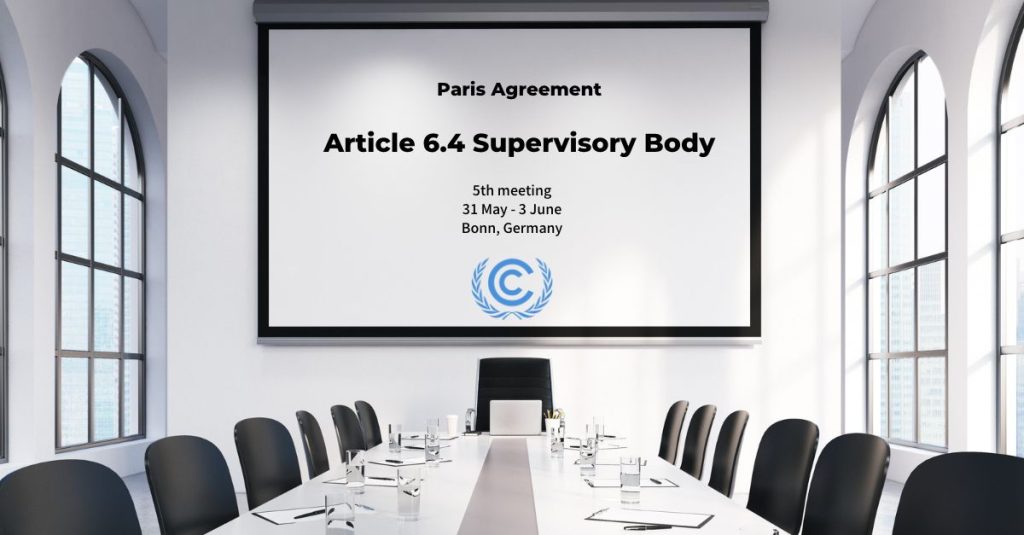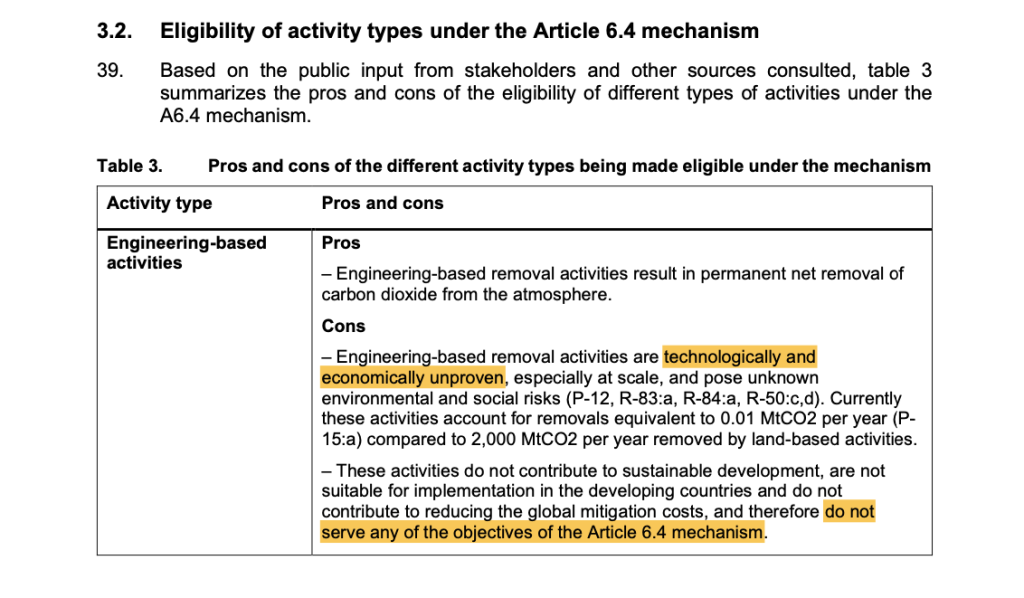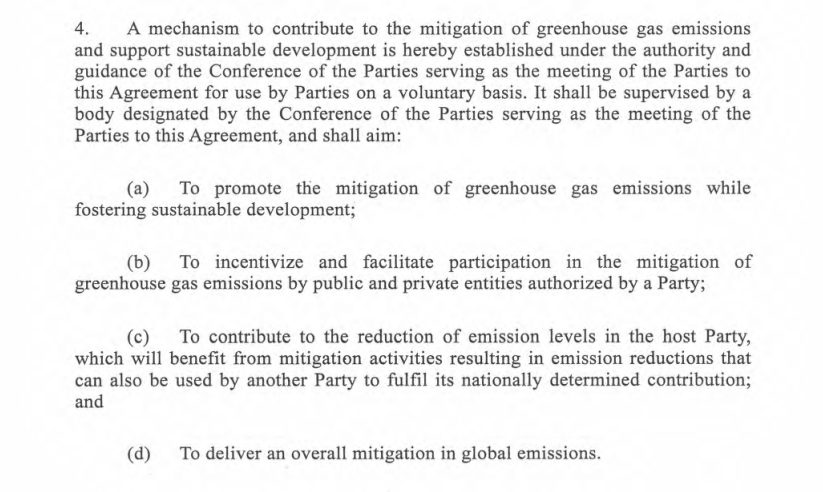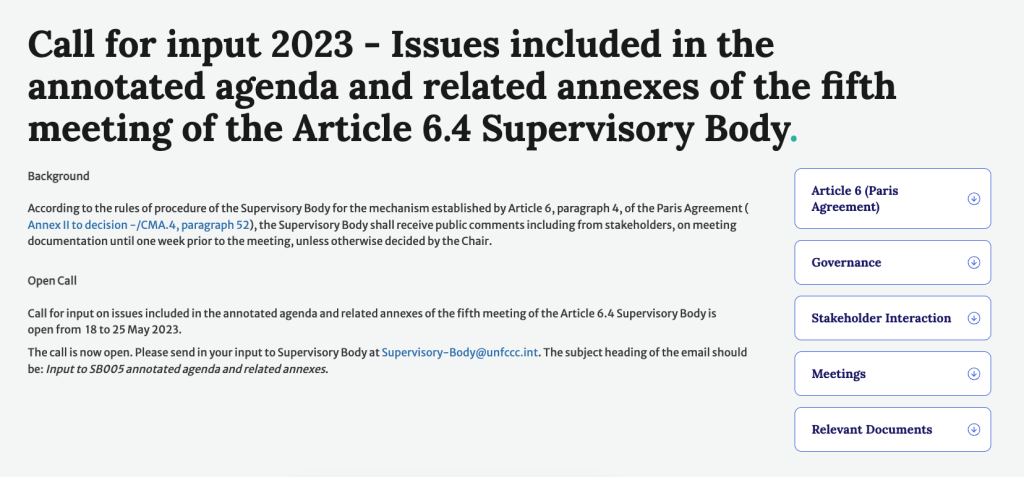The UN standard-setters are continuing their deliberations on removals under the Paris Agreement. The upcoming 5th meeting of the Article 6.4 Supervisory Body has a busy agenda and one particular document has captured the interest of stakeholders due to its unbalanced perspective on carbon removal. In response to numerous requests for calls, meetings, and submission input, this blog post aims to shed light on the process, the pertinent considerations, and advice on how to engage with impact.
A short disclaimer before getting started. Emission reductions should be prioritised over removals, all types of removals are needed to achieve the Paris Agreement temperature goal, carbon markets are one of many tools in climate policy to incentivise climate action, and Article 6.4 mechanism under the Paris Agreement covers both emission reductions and removals. This blog post focuses narrowly on removals in the context of the Article 6.4 mechanism.
If you’re new to the topic, check out these three posts for background: (1) the Article 6.4 mechanism under the Paris Agreement carbon markets and why it matters for removals, (2) the summary of carbon removal developments at COP27 and outlook for COP 28, and (3) an overview of the March 2023 Article 6.4 Supervisory Body meeting from removals perspective.

From past to present — progress and plan for 2023
The COP27 decision mandated the Supervisory Body to “elaborate and further develop” their work on removals over 2023, building on stakeholder input. Over the coming meetings this year, the Supervisory Body will prepare a dual set of recommendations on removals and methodologies that will be up for consideration at COP28 in Dubai.
These recommendations on removals and methodologies will set up the general framework which will guide the upcoming work, incl on the methodologies for removals. It’s somewhat comparable to setting the general framework for removals in Europe with the Carbon Removal Certification Framework (CRCF) whilst the methodologies will follow later on. The timetable of Article 6.4 mechanism (recommendations to be adopted in Nov 2023) and the EU CRCF process (to be agreed upon in Q1 2024) are quite similar. It remains to be seen which process will become operational earlier.
So far, stakeholders have submitted their views on removals under Article 6.4 in September 2022 (2 submissions), October 2022 (52 submissions), November 2022 (3 submissions), and March 2023 (32 submissions).
At the time of writing, there is an open call for input until 25 May 2023 for the upcoming 5th Supervisory Body meeting. Removals are one of several items on the agenda, and many stakeholders have noticed the surprising take in the information note prepared by the UNFCCC Secretariat.
An unexpected take on carbon removal
The information note has been built up over several iterations since the fall of 2022 (V1, V2, V3 and now V4). It is prepared by the UNFCCC Secretariat and “has been revised to include the guidance of the Supervisory Body as well as the views of Parties and observers“. Its purpose is to “support the work of the Supervisory Body in developing recommendations on activities involving removals“.
The note serves as a background document, compiling the details needed to develop the main document that will be submitted for adoption at COP28 — “Recommendation. Activities involving removals under the Article 6.4 mechanism”.
This is to explain that it is not an operative document being prepared for adoption.
However, its content still matters.

The reactions and comments to my LinkedIn and Twitter posts drawing attention to the topic have led to intense discussions and sparked interest in the media.
The note should offer a balanced overview of a range of carbon removal activities, based on the latest science (the IPCC Sixth Assessment Report is conveniently ready), and input from the Supervisory Body, countries and stakeholders.
Instead, we see something quite different.

The note deems all engineered removals technologically and economically unproven, not contributing to sustainable development, and claims that engineered removals do not serve any of the objectives of the Article 6.4 mechanism.
It’s not only the take on engineered removals that is problematic. By comparison, the list of land-based activities is surprisingly short on cons, leaving out competition for land, food and water and much more that regularly feature in the IPCC reports.
Looking at the two side by side, or in this case, above and below, shows an approach that seems to strongly disadvantage engineered removals, to the extent of excluding these from the scope of Article 6.4 mechanism, and making the list more advantageous for land-based removals.

Having the UNFCCC Secretariat prepare a document that is so obviously imbalanced raises eyebrows and questions.
Let’s take stock of what has gone wrong.
1. The science
The note ignores the science. And the science is clear: next to steep emission reductions, removals are needed to (1) further reduce net emission levels, (2) balance residual emissions to help reach net-zero emissions, and (3) achieve and sustain net negative emissions. All types of removals (land-based and engineered) will be needed to make this a reality because all have limitations.
2. Pros and cons
The note pics and chooses pros and cons instead of offering a scientifically informed and balanced overview. A good example of a balanced comparison with pros and cons is in the IPCC AR6 WG3 full report table 12.6 “Summary of status, costs, potentials, risk and impacts, co-benefits, trade-offs and spillover effects and the role in mitigation pathways for CDR methods”, or even more detailed take in the State of CDR report comparison table on pages 18-19.
3. Stakeholder input
There is a long list of stakeholder input that highlights the role of engineered removals (from Sept 2022, Oct 2022, Nov 2022, and March 2023). Most of this has been ignored in the note by judging all engineered removals to be technologically and economically unproven, and ultimately by suggesting to leave engineered removals out of the scope of Article 6.4.
4. Countries’ climate targets
An increasing number of countries rely on engineered removals to achieve their climate targets, with BECCS being the most common but other methods are slowly gaining attention. Leaving such removals left out of the Article 6.4 mechanism scope makes it more difficult to achieve the increasingly ambitious NDCs over the coming decades. Article 6.4 is not a tool for the next five years or the next ten years — it’s part of the toolbox to achieve net zero emissions globally. Removals will become increasingly important in countries’ climate change mitigation activities.
5. The objective of Article 6.4 of the Paris Agreement
The information note claims that engineered removals don’t serve any of the objectives of the Article 6.4 mechanism. The list below, considered in combination with the points above, proves such a claim to be baseless. (FYI removals are part of climate change mitigation)

6. Global methodologies for removals
Article 6.4 is widely expected to deliver a global standard for methodologies for carbon removal activities, especially for novel removal activities where a lot is still being developed. Other carbon markets are currently keeping an eye on these developments. Leaving engineered removals out of the scope of Article 6.4 would be a missed opportunity to establish robust methodologies on a global level.
What can the stakeholders do?
There are established communication channels in how Article 6.4 Supervisory Body works. When it comes to the UNFCCC, “in this process, process is substance“.
Documents are published before each meeting, and stakeholders have a week to react. A massive reaction now will indicate that something is wrong. A lack of reaction will indicate everything is fine. Sharing concerns on social media or media outlets, whilst helping with capacity building and sharing information, is not part of the formal communication and can’t be taken into account in the official processes of the Supervisory Body.
So, the stakeholders need to use this call for inputs, due 25 May, to formally communicate if their previous submissions have not been taken into account or have been reflected with bias in the meeting documents. Other relevant aspects and pointers (I listed my personal take in the previous section) will no doubt be useful to make the case.

Engaging with the Supervisory Body members is always an option but won’t replace engagement through the official call for input. Bear in mind that the information note on removals has been drafted by the UNFCCC Secretariat, not the Supervisory Body members.
To keep up with the process, stakeholders can attend the meetings as observers which also offers an opportunity to engage at the meeting (the registration deadline is three weeks before the meeting), follow the live stream of the meeting, or watch the recording afterwards.
After the 5th Supervisory Body meeting, the next major milestone for removals is the launch of the structured public consultation on removal activities, due to be launched in June 2023.
Conclusion
Article 6 of the Paris Agreement has immense potential to increase climate ambition. A new report shows it can double emissions savings under the Paris Agreement. The centralised Article 6.4 mechanism can play an important role in making that a reality.
It’s important to get the governance of removals right under Article 6. There is a growing ecosystem of novel removal methods and many of these are poised to be used by countries in their climate targets. Removal stakeholders have been actively contributing to the Article 6.4 process to date, and that has to continue if the mechanism was to succeed.
The imbalanced information note published before the 5th Supervisory Body meeting requires attention and revision. It’s time to read up, get engaged, establish expertise and/or collaborate with those who have it, and help shape the global rules for carbon removal. Submit your input by 25 May 2023.
***
Thank you for reading! Sign up for updates below, and stay tuned for the next posts.
Would you like to use (parts of) the text? Go ahead on the condition that you explicitly refer to this post and include a link.
Thank you!

